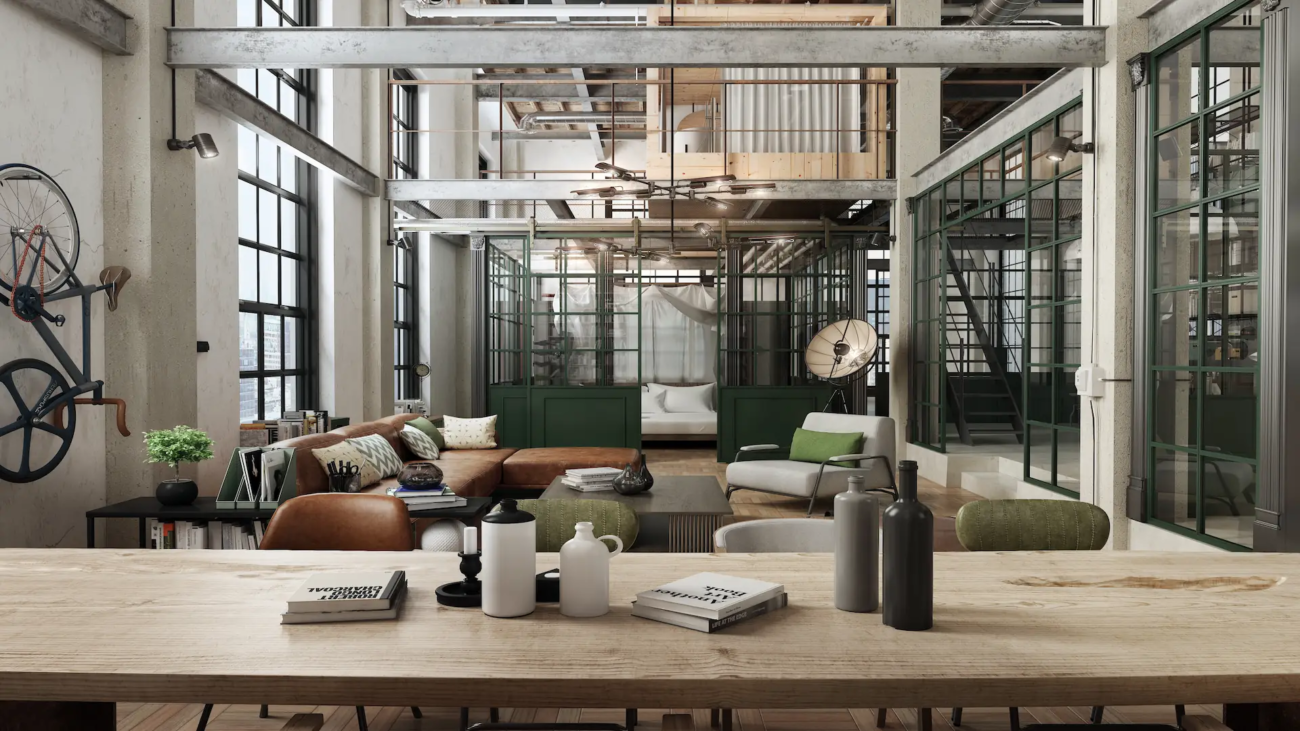Industrial style has stopped being just a trend and has become a lifestyle. Inspired by the old factories of New York, this style combines authenticity, functionality, and urban aesthetics. Its appeal lies in the ability to create spacious, honest environments with a distinct character in both homes and offices.
What is Industrial Style in Decoration?
Industrial style in decoration is inspired by the architecture of factories and warehouses from 1950s New York. It was born when artists and creatives began converting these abandoned spaces into loft-style homes while preserving the original structure.
Its essence is to showcase the truth of the space: exposed bricks, visible pipes, and unhidden metal structures. This aesthetic celebrates imperfection and the history of materials, transforming the functional into beautiful.
The central philosophy of industrial style is based on two pillars: honesty and functionality. It doesn’t seek to hide defects but to highlight them as part of the identity of the place. This “imperfect beauty” deeply connects with the contemporary spirit of those who value authenticity over artifice.
Moreover, this style naturally aligns with the modern professional: independent, creative people constantly on the move, like digital nomads. Open, bright, and versatile spaces fit perfectly with a flexible lifestyle where work and home merge.
Key Elements to Achieve an Industrial Style in Your Home
Before discussing furniture and accessories, it’s essential to understand the architectural and visual foundations of industrial style.
- Exposed architecture: The main characteristic is leaving the structures visible. Beams, columns, ventilation ducts, or wiring are integrated as part of the design. Spaciousness is achieved through open spaces and high ceilings, two features inherited from factories.
- Raw materials: walls and floors: Exposed brick is the absolute protagonist, followed by polished concrete or cement. These materials add texture, visual continuity, and a sense of authenticity. If you can’t renovate, there are wallpapers or coverings that mimic their appearance very realistically.
- Natural light and large windows: Large metal-framed windows are essential. This style promotes spaces full of natural light, reducing the need for artificial lighting and fostering energy efficiency. Light curtains or glass partitions with steel frames allow division without reducing luminosity.
- Color palette: Grays, blacks, and browns dominate the palette, adding sobriety. To soften the overall effect, warm touches through wood, leather, or textiles in beige and earth tones are recommended. A dark green or deep blue accent can add personality without breaking harmony.
- The tenant challenge. Non-permanent solutions: For those living in rental properties, there are simple ways to recreate this style without renovations. Opting for clean-lined furniture, large mirrors, and careful lighting can completely transform a space. The trick is to mimic the spaciousness and texture with reversible resources.
Essential Furniture and Materials for an Industrial Look
Furniture is the tangible base of industrial style. The key materials are metal, wood, and leather, known as the “industrial trinity.”
Metal, wood, and leather
Matte black or aged metal defines the structures. Natural wood, without varnishes or lacquers, adds warmth. Aged leather completes the composition, especially in sofas and armchairs.
Iconic pieces of the style
- Chesterfield Sofa: Upholstered in aged leather, it is a symbol of industrial elegance.
- Tolix Chair: Metal, stackable, and functional, representing the factory aesthetic.
- Solid wood tables with iron legs bring robustness and balance.
- Modular metal and wood shelves, or restored old lockers, add authenticity.
Lighting with character
Metal pendant lamps and exposed filament light bulbs are indispensable. They bring warmth and visual drama. A warm light balances the cold materials like cement or iron, creating comfort.
Investing in these iconic pieces, like a designer lamp or a Chester sofa, not only beautifies the space but also makes it more attractive to potential tenants.
In fact, certain accessories can increase a property’s value, as they add character and functionality, transforming a standard space into a home with personality.
Tips for Combining Industrial Style with Other Trends
The biggest challenge of industrial style is avoiding coldness. The key is to fuse it with complementary styles that bring light or warmth.
- Industrial-Scandinavian: Both styles share a love for simplicity. White walls, light wood, and black metal create bright and functional spaces. Ideal for small homes seeking visual spaciousness.
- Industrial-Bohemian: Combines urban structure with the richness of Boho textures. Jute rugs, colorful cushions, and indoor plants soften the hardness of metal and concrete. The result: a cozy, artistic, and lively space.
- Industrial-Minimalist: The purest version of the style. Unnecessary adornments are eliminated, maintaining a strict neutral palette. Ideal for those who value order and serenity.
- The power of textiles: Regardless of the fusion, textiles are the universal resource to balance the environment. Wool or linen rugs, large cushions, and tactile throws add texture and warmth, breaking the rigidity of hard surfaces.
Adopting industrial style in decoration doesn’t mean sacrificing comfort. It’s an invitation to rediscover the beauty of the essential: raw materials, natural light, and open spaces. Whether in a home or office, this style offers the perfect balance between aesthetics, functionality, and sustainability.
Recent interior design trends confirm that industrial chic remains one of the most influential movements of 2025, capable of adapting to any environment without losing its essence.
Book Now on BizTrip

